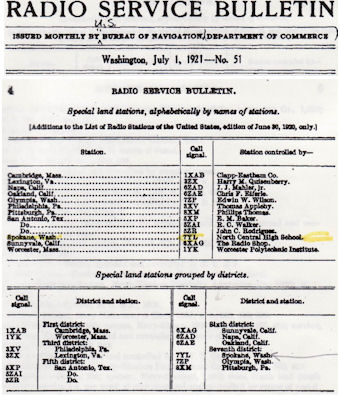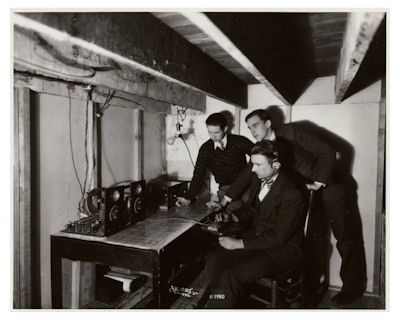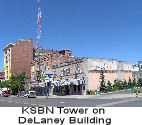KFIO AT NORTH CENTRAL HIGH SCHOOL
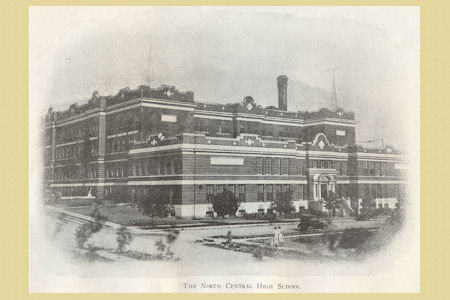
Sketch from the North Central High School Yearbook, "The Tamarack," January 1925. If you look carefully, you can see the two 45-foot high steel towers on the roof, which were installed by the NC Radio Club.
(Click on the image and the images below for larger views.)
An Original Educational Station
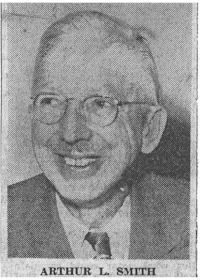
Under the guidance of physics teacher Arthur L. Smith, North Central High School established first a telegraphic station with the call sign 7YL in 1921 and then later a broadcast station with the call KFIO in 1923. KFIO could be considered an original educational radio station. Despite some difficulty in and controversy over keeping the station on the air, many of the people who became radio broadcast professionals in Spokane and nearby communities in the early radio days got their start in radio at KFIO thanks to Mr. Smith's foresight.
Radio Club Founded in December 1920
The North Central High School Radio Club was organized in late 1920 under the sponsorship of Arthur L. Smith. The club's constitution was drafted and ratified on 21 December 1920. Fred Lawrence was selected as the club's first president. Lawrence stated that "the object of the new organization will be to promote in every possible way among students of the high school, the art of radio work."
Licensed as a Special Land Station in 1921 - 7YL
Mr. Smith sought a Special Land Station Radio License for the North Central High School Club, and according to the Department of Commerce's Radio Service Bulletin dated 1 July 1921, the school received such a license with the call 7YL. (Special land stations were a class of stations used by experimenters, technical and training schools, and certain amateur radio operators.) With this license students at North Central High School could now learn telegraphy and radio theory, and then apply what they learned in real life.
According to a school newspaper article of January 1922, the club sought in December 1921 to have the study of radio as an accredited school subject in the following year. It is not known if they were successful. The club also discussed erecting a new antenna or making changes to the existing antenna and had built an amplifier. The club members were also building their own radio sets. Later in 1922, the club planned to erect two 45-foot high steel towers. A radiotelegraphy capable "continuous wave set would be installed as soon as a sutiable aerial and counterpoise are erected."
The NC Radio Club was a member of a radio club sponsored by the Pacific Telegraph Institute (PTI) at 119 North Post Street in Spokane. According to a newspaper article of October 1922, the PTI club was divided into elementary and advanced classes. Mr. R. T. Carr of the PTI noted that the club had about 70 members, and expected enrollment to reach 200 members over the winter.
(NOTE: R. T. Carr was the signatory for the license of KOE, the radio station owned by the Spokane Chronicle and the later versions of radio station KFZ.)
Also in October 1922, the club discussed issues involving the building of a detector, and a two-stage amplifier for the club's new Amarad short wave receiver.
In November 1922, club members heard an interesting presentation about the then-modern application of using radio-telephone technology for things other than broadcasting. One of the examples cited was the "splendid work accomplished by the southern California Edison company with the use of radio phones in places where it was either impossible or impracticable to install and operate regular telephones" as well is the use of radio telephones in mines.
The club had issues with their receivers because signals from the west were fading and signals to the south were coming in much stronger. This effect appeared to be a general phenomenon as it was noted on all received. Mr. Edmund Craney of Radio Station KFDC and Mr. Smith made suggestions about how to overcome this undesirable effect.
In February 1923, the club decided to "install a temporary five-watt sending set to handle the traffic until the large permanent set is installed." Two club members were appointed to build the set. There was no mention of using radio telephone with this temporary set.
Getting Ready for a Broadcast Station
In April 1923, the club discussed building a broadcasting station and obtaining "a room for the exclusive-use of radio." The club had put together about two-thirds of a transmitting set. According to a newspaper article of the time, "when the set is built the club hopes to get a broadcasting license and send out programs."
Licensed as a Broadcast Station in 1923 - KFIO
Frequently special land stations became broadcast stations after the Commerce Department created the broadcast station class in September 1921. A broadcast station is loosely defined as a licensed radio station, which had voice and music, and broadcast to an audience on a regular schedule. On 22 May 1923, North Central High School received a broadcast station license with the call letters of KFIO.
KFIO Did Not Broadcast Programs Right Away
However, there is no record of the club broadcasting right after it received the license on 22 May 1923. In fact in a June 1923 school paper article, the club's new set committee chairman Arthur Peterson stated, "the North Central Radio club will try to broadcast a radio program on its new C.W. set before school is out." Unfortunately, there is no record of the club doing this or not. Therefore, the exact date the station started broadcasting radio programs remains unknown. Furthermore, there is no evidence in the early records that the radio club ever broadcasted voice prior to 22 May 1923. However, there are some indications that the club may have experimented with radiotelegraphy using the call letters 7YL.
North Central High School Radio Club retained the call letters 7YL for several years and later North Central's amateur radio station became W7YL. As of this writing, the call W7YL was assigned to an amateur radio operator who lives in Hawaii.
Student Operated Station
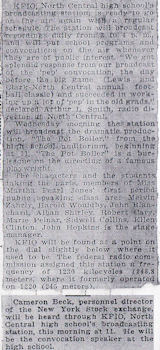 Students who were members of NC
Radio Club operated KFIO. In the history page on North Central
High's website, KFIO was said to have broadcast features such
as NC News, entertainment that included concerts by the school
band and orchestra (live from the auditorium) and sports events,
in particular games between North Central High and Lewis and
Clark High in 1924 and 1925.
Students who were members of NC
Radio Club operated KFIO. In the history page on North Central
High's website, KFIO was said to have broadcast features such
as NC News, entertainment that included concerts by the school
band and orchestra (live from the auditorium) and sports events,
in particular games between North Central High and Lewis and
Clark High in 1924 and 1925.
In addition to Friday evening programs, the station also broadcast during school time Monday to Friday and occasionally on Sunday evenings.
D. Windsor Hunt, who worked at the station as a student beginning in 1927, related his experiences at the station and talked about what kind of programming the station broadcast. He noted that, among other things, he was responsible for reading the news, playing records, announcing school athletic events, and proms. The station had a library of records, all 78 RPM, mostly from the 1910's, but they also were able to get a hold of more recent hits of the time. Hunt noted that they obtained a copy of the the record "Sweet Hearts on Parade" when it was still number one on the hit parade. Hunt also related they would read the news verbatim from the Spokesman-Review and the Spokane Chronicle, but they gave no credit to the original sources. As they read the articles they had to be careful to avoid mentioning divorce, sex, or bootlegging as those topics were considered taboo!
The newspaper clipping shown in this section was included in the station's license renewal package dated 15 Jan 1929.
To see a detailed account of D. Windsor Hunt's experiences at KFIO when it was at North Central High School as well as his other radio related experiences in Spokane, click here.
Crowded Quarters
The studio was in crowded quarters in an upper floor in the south end of the high school building. The only description that the author has been able to find is the account related by D. Windsor Hunt for the Early Days of Spokane Radio.
"... The [transmitter] was in a closet about 8' X 16', between the physics lab and classroom, on the south side of the 3rd floor. ...
"... The transmitter took up about six square feet and a two foot passage alongside led to the studio. This was the back of the room with one window to an airwell. It was about 8' X 12'. ...
"On the right side was the "console" - a bench about two feet wide with one turntable mounted on it. Later we got a variable speed job, but we didn't have LP (long play, not liquid petroleum) records so we never used it in my time. ...
"Someone loaned Mr. A. L. Smith a mechanical song bird from Europe - a wind up dealy in a big brass cage. Every 15 minutes it sang a line in a very beautiful realistic bird song. On the hour it sang a longer trill. It not only warned us of the time but often added a nice touch to the announcements. ..."
A complete description of the transmitting plant can be found at the Spokane Radio Tower website.
by Bill Harms - Updated 14 May 2009
NEXT - KFIO's move to the Pedicord Building; Transition to a Commercial Station.
SOURCES:
- Hunt, D. Windsor. Account of KFIO in the Late 1920's and Early 1930's. Written for the Early Day's of Spokane Radio, 1980.
- KFIO License for Land Radio Station, Class Limited Commercial., Radio Service, Bureau of Navigation, Department of Commerce, Washington, DC. 22 May 1923.
- KFIO Radio Broadcasting Station License, Federal Radio Commission, Washington, DC. 15 January 1929.
- North Central High School History. http://www.spokaneschools.org/northcentral/history/NC_History.htm Last accessed 25 May 2008. COMMENT: The web page consisted of a list of highlighted events from the history of North Central High School. The original sources are not known, but assumed to be from the high school's archives.
- Radio Service Bulletin. No. 51. Bureau of Navigation, Department of Commerce, Washington, DC. 1 July 1921.

